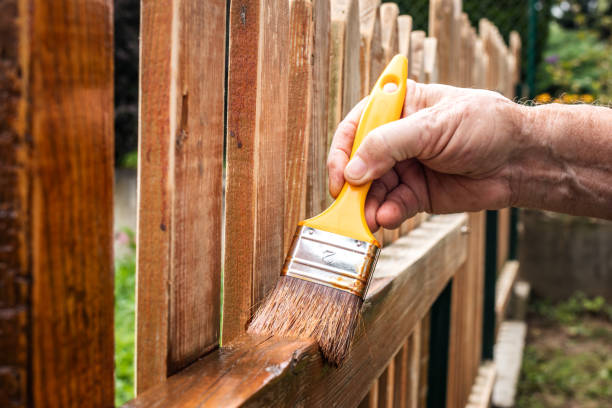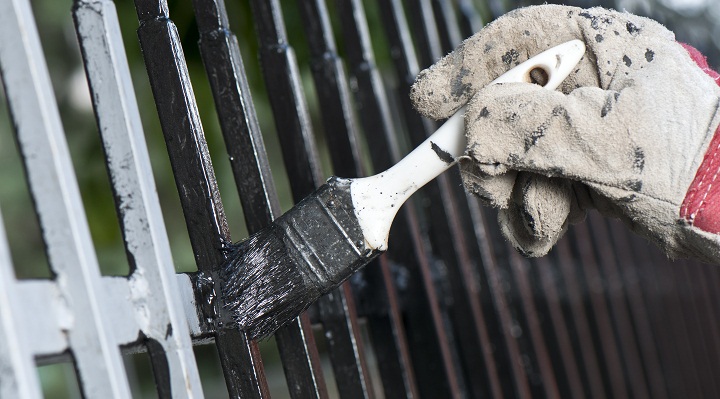Is your boundary fence looking a bit worse for wear? No worries, mate! We've got you covered with this ripper guide to keeping your fence spick and span for yonks to come. Whether you've got a classic timber paling fence, a sleek Colorbond number, or any other type of fence, we'll show you how to give it some proper TLC.
Why Bother with Fence Maintenance?
Before we dive in, let’s chat about why keeping your fencing in top condition is so crucial:
Kerb Appeal: A clean, well-maintained fence can make your property look exceptional! It’s like giving your home a fresh, appealing facelift.
Longevity: Regular care can extend your fence’s lifespan, saving you money over time. Think of it as a solid investment in your property’s future.
Property Value: Believe it or not, a high-quality fence can actually enhance your property’s value. How’s that for a win?
Early Problem Detection: Routine inspections help you identify and address minor issues before they become major problems. It’s like a health check-up for your fence!
Safety and Security: A well-maintained fence ensures your property remains secure and your loved ones stay safe.
Environmental Protection: Proper upkeep shields your fence from harsh weather conditions, from intense sun to heavy rains.
Neighbourhood Relations: A tidy, well-kept fence shows respect for your neighbours and helps maintain good relations. No one wants to look at a dilapidated fence next door!
Now that we’ve covered the importance of boundary fencing maintenance, let’s roll up our sleeves and get started!
General Fence Cleaning Tips
No matter what type of fence you've got, these general cleaning tips will come in handy:
Start with a Clean Slate: Give your fence a good once-over, removing any loose debris, cobwebs, or vegetation. A stiff broom or leaf blower can be a real time-saver here.
Choose the Right Tools: Soft-bristled brushes, garden hoses, and pressure washers (on a low setting) are your best mates for this job. For tougher stains, consider a specialized fence cleaning solution.
Work from Top to Bottom: Gravity is your friend here. Start at the top and work your way down to avoid creating more work for yourself.
Be Gentle: Don't go at it like a bull at a gate! Aggressive scrubbing can damage your fence's finish. Easy does it!
Safety First: Chuck on some gloves, safety glasses, and appropriate clothing. If you're using a pressure washer or cleaning chemicals, take extra precautions.
Mind the Weather: Choose a mild, overcast day for cleaning. Extreme heat can cause cleaning solutions to dry too quickly, while rain can make a real dog's breakfast of your efforts.
Protect Your Plants: Cover nearby plants with drop cloths to protect them from cleaning solutions and debris.
Test First: Before going all out, test your cleaning method on a small, inconspicuous area to ensure it won't damage the fence.
Rinse Thoroughly: Always rinse your fence well after cleaning to remove any residual cleaning products.
If your boundary fences double as a dividing fence between yours and your neighbour's property, you must remember that while cleaning your fence, you must also ensure that you are not encroaching on your neighbour's side. It is essential to maintain clear communication and respect boundaries to avoid any disputes or conflicts over the boundary fencing.
Cleaning Different Fence Types

Timber Fences
Timber fences, like the classic paling fence, need a bit of extra love to keep them looking their best:
Mix a Gentle Cleaning Solution: Combine warm water with a mild detergent or specialised timber cleaner. For a natural option, mix one part white vinegar with two parts water.
Pre-Wet the Fence: Give the fence a light spray with water to prevent the wood from soaking up too much cleaning solution.
Apply and Scrub: Use a soft-bristled brush to work the solution into the grain. For stubborn stains, let the solution sit for a few minutes before scrubbing.
Rinse Thoroughly: Use a garden hose to rinse off all the soap and grime. A pressure washer on a low setting can be used, but be careful not to damage the wood.
Let it Dry: Give the fence a chance to dry completely before applying any treatments. This usually takes 24-48 hours, depending on the weather.
Sand if Necessary: For rough patches or stubborn stains, a light sanding can work wonders. Always sand in the direction of the wood grain.
Apply a Protective Finish: Once clean and dry, slap on a water-repellent sealer, stain, or paint to protect the wood from moisture and UV damage.
Colorbond and Metal Fences
For those modern Colorbond fences that are all the rage:
Prepare a Soap Solution: Mix warm water with a gentle, non-abrasive detergent. Avoid harsh chemicals that could damage the coating.
Wipe Down: Use a soft cloth or sponge to clean the fence panels. For tougher stains, a soft-bristled brush can be used gently.
Rinse Well: A quick spray with the garden hose should do the trick. Make sure all soap residue is removed to prevent streaking.
Dry Off: Wipe down with a clean, dry cloth to prevent water spots and promote even drying.
Check for Damage: While cleaning, keep an eye out for any scratches or chips in the coating. These can be touched up with Colorbond touch-up paint to prevent rust.
Remove Debris: Pay special attention to the bottom of the fence panels and posts where debris can accumulate and cause corrosion over time.
Vinyl and PVC Fences
These low-maintenance options are a breeze to clean:
Hose it Down: Often, a good spray with the garden hose is all you need to remove dirt and debris.
Tackle Tough Stains: For stubborn marks, use a mixture of white vinegar and water (1:3 ratio) or a specialized vinyl cleaner.
Gentle Scrub: Use a soft brush or cloth to remove any remaining dirt. Avoid abrasive scrubbers that could scratch the surface.
Rinse and Dry: Give it a final rinse and let it air dry. For a streak-free finish, you can wipe it down with a microfiber cloth.
Mould and Mildew: For any mould or mildew, use a solution of 30% vinegar and 70% water. Apply with a sprayer, let sit for 20 minutes, then rinse thoroughly.
Wrought Iron Fences

These classic beauties require special care to prevent rust:
Remove Loose Rust: Use a wire brush to remove any loose rust or flaking paint.
Clean with Soapy Water: Use a mild detergent solution and a soft brush to clean the entire fence.
Rinse and Dry: Thoroughly rinse with clean water and dry completely with a clean cloth.
Treat Rust Spots: For any remaining rust, apply a rust converter following the product instructions.
Prime and Paint: Once clean and rust-free, apply a metal primer followed by a rust-resistant paint designed for outdoor use.
Maintenance Tips for Long-Lasting Fences
Cleaning is just half the battle. Here are some top tips to keep your fence standing tall for yonks:
Regular Inspections: Give your fence a once-over every few months to catch any issues early. Look for signs of wear, damage, or pest infestation.
Trim Nearby Vegetation: Keep plants and trees trimmed back to prevent damage and reduce moisture build-up. Aim for at least 30cm clearance around your fence.
Address Damage Promptly: Don't let small problems fester. Fix loose boards, rust spots, or chipped paint ASAP to prevent further damage.
Reapply Protective Finishes: For timber fences, reapply stains or sealants every 2-3 years, or as needed. This protects against moisture and UV damage.
Tighten Hardware: Check and tighten any loose screws, nails, or brackets. Replace any rusted or damaged hardware.
Mind the Gap: Ensure your fence maintains a small gap (about 5cm) from the ground to prevent moisture damage and rot.
Clean Gutters and Fix Drainage Issues: Make sure water doesn't pool around your fence posts, as this can lead to rot and instability.
Pest Control: Keep an eye out for signs of termites or other wood-boring insects, especially for timber fences.
Annual Deep Clean: Perform a thorough cleaning at least once a year, more often in areas with high pollution or lots of tree coverage.
Adjust Gates: Check gate hinges and latches regularly, adjusting as needed to ensure proper alignment and function.
DIY Fence Repair Tips
For minor issues, a bit of DIY can go a long way:
Replacing Wooden Pickets: Remove damaged pickets by unscrewing or prying them off. Cut a new picket to size, paint or stain to match, and secure it in place.
Fixing Loose Posts: For slightly loose posts, use a post support bracket. For severely loose posts, you may need to re-set them in concrete.
Patching Small Holes: In wooden fences, use wood filler for small holes. For larger holes, cut a piece of wood to fit and secure it with wood glue and screws.
Treating Rust Spots: For metal fences, sand down the rusted area, apply a rust converter, then prime and paint to match the fence.
Straightening Leaning Sections: Use a turnbuckle system to gradually straighten leaning fence sections. Be sure to address the underlying cause of the lean.
Be Mindful of Local Government Regulations: Even when you are only doing DIY maintenance work on your fence, it is crucial to be aware of any local government regulations regarding boundary fencing. This includes understanding height restrictions, materials allowed, and any maintenance and building permits or approvals that may be required.
When to Call in the Pros
While regular cleaning and maintenance can go a long way, sometimes you need to bring in the big guns. If you're facing any of these issues, it might be time to call in a professional:
Significant rot or rust
Leaning or unstable sections
Multiple broken or damaged panels
Need for a complete refinish or repaint
Pest infestation
Structural issues with posts or footings
Large-scale damage from storms or accidents
Eco-Friendly Fence Maintenance
For the environmentally conscious homeowner, here are some green tips:
Use Natural Cleaners: Opt for vinegar-based solutions or eco-friendly commercial cleaners.
Collect and Reuse Water: Use a bucket to collect runoff water for watering plants (if not using harsh chemicals).
Choose Sustainable Materials: When replacing parts, opt for sustainably sourced timber or recycled materials.
Proper Disposal: Dispose of old fence materials and chemical cleaners responsibly. Check with your local council for proper disposal methods.
Preparing Your Fence for Extreme Weather
In Australia, we're no strangers to harsh weather. Here's how to prepare your fence:
Bushfire Season: Clear vegetation around the fence and consider fire-resistant treatments for timber fences.
Cyclone Season: Reinforce posts and ensure all parts are securely fastened. Consider temporary bracing for severe weather events.
Flood-Prone Areas: Ensure proper drainage around fence posts and consider water-resistant materials or treatments.
Wrapping Up
Crikey, that's a lot of info! But now you're well-equipped to keep your fence in tip-top shape for years to come. Remember, a little effort goes a long way when it comes to fence care. So grab your cleaning gear, put on some tunes, and give your fence the love it deserves. Your future self (and your property value) will thank you!

